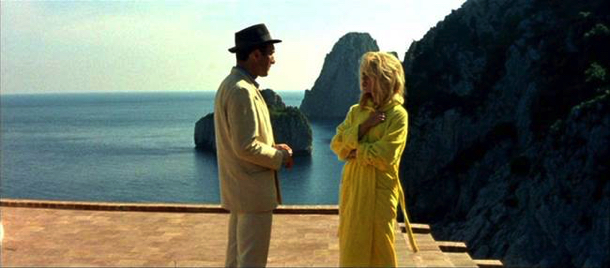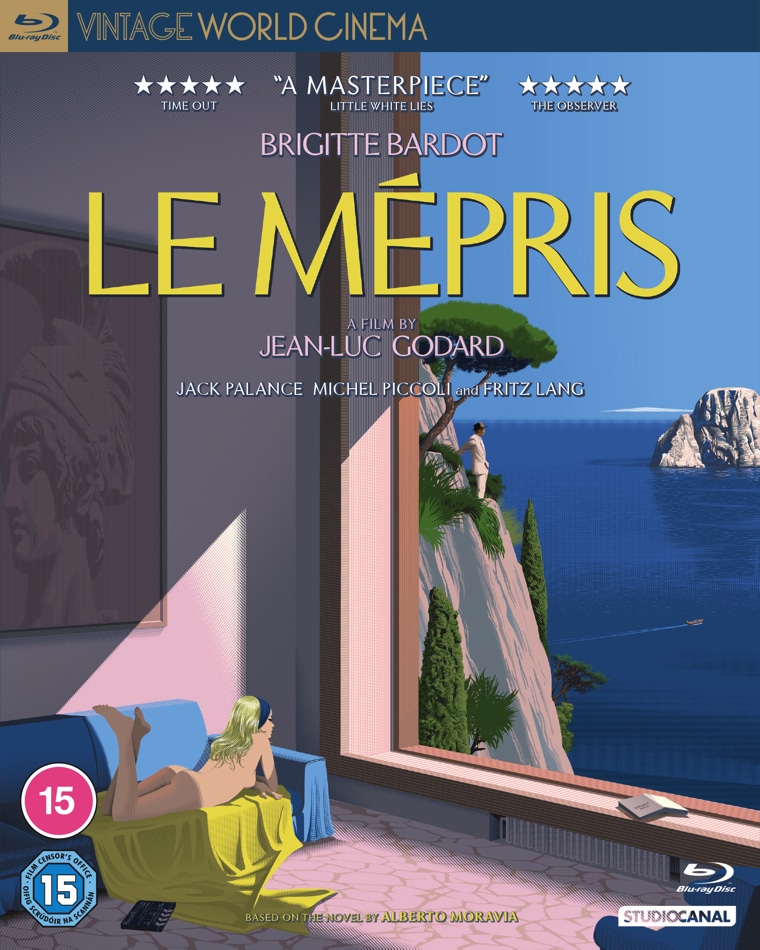




Dir: Jean-Luc Godard | Cast: Brigitte Bardot, Michel Piccoli, Jack Palance, Georgia Moll, Fritz Lang, Jean-Luc Godard | France/Italy 1963, 103 min.
For JL Godard LE MÉPRIS was just ”a film without mystery, an Aristotelian film, freed from appearances [it] proves in 149 shots, that in cinema, just like real life, there is nothing secret…there is nothing to do but live – and film”.
Godard’s producers, among them Carlo Ponti and Joseph E. Levine, must have been quite shocked by the austere outcome; they insisted on an additional scene, showcasing Brigitte Bardot’s beauty, only to be outmanoeuvred by the director himself.

Based on Alberto Moravia’s novel “Il Disprezzo’ (The Ghost at Noon), this film about filmmaking starts with the basics: a dolly on rails follows Georgia Moll’s Francesca Vanini who walks towards the camera. Her husband Paul (Piccoli), was supposed to entice a mass audience. But Godard simply subverted the call for any form of eroticism, letting Camille ask Paul which parts of her anatomy he loves the most – the obvious answer is everything. Meanwhile she lies unruffled and statuesque as he lists her body parts. Strangely, these are the only happy moments Camille and Paul will have enjoy during the whole film. When Paul, a scriptwriter, later meets the American producer Prokosh (Palance) in Rome’s Cinecitta, Camille feels her husband is pimping her out to the arrogant, misogynist and dictatorial producer who exclaims: “I like Gods, I know exactly how they feel”. In addition, he is treating his well-educated assistant and translator Francesca Vanini (Moll) like a slave.
In a preview theatre with Fritz Lang – as himself, Paul and Camille bear witness to Prokosh going off on one. He is unhappy about Lang’s rushes, so he reacts by kicking the film rolls around the room and then has Vanini bend over so he can write a cheque for Paul on her back while shouting: “When the Nazis heard the word culture, they drew a revolver; I am only writing a cheque”, Prokosh hands Paul the cheque: ten thousand dollars to pay the mortgage for Camille and Paul’s flat in Rome. When Paul grudgingly accepts the cheque, he loses his wife.
In a breath-taking 34 minute sequence in the couple’s flat, Godard follows the unravelling of their relationship with tracking shots which show the growing distance between the couple. These finally unravel in one frame in two different rooms, divided by a wall. Paul slaps Camille i, she hits him back, he retreats, but it is too late: Camille shouts angrily: “When you were writing crime novels, we were broke, but that was fine with me”.
The love next where they conducted their relationship, has soon become a millstone round their necks. Paul still believes he can save his marriage but seems to have learned nothing: when the film crew moves on to Capri, Paul again leaves Camille, against her will, alone with Prokosh, who obviously fancies her. This time Camille retaliates: she kisses the producer in full view of Paul. Then she packs her bags and leaves for Rome, Paul terminating his contract with Prokosh. To humiliate Paul even further, Camille allows Prokosh to drive her to Rome. Their journey ends in a fatal crash, which is not shown, Godard makes fun of mainstream movies by showing the dead bodies all mangled in grotesque positions, with the last words of Camille’s good-bye letter to Paul superimposed: “Take Care. Adieu. Camille”.
LE MÉPRIS ends with a beautifully serene shoot in Capri, where Godard acts as Lang’s assistant in capturing the scene when Odysseus returns to Ithaca. As Godard pointed out “the film is shot entirely in real locations, both exteriors and interiors, honest and authentic”. One of them is the gorgeous villa of the Italian author Curzio Malaparte on Capri, designed by Alberto Libera, it sits like a space ship in the sun. In the panorama shots, the film crew with their equipment look entirely out of place. Movie posters of Hitchcock’s Psycho and Nicholas Ray’s Bigger than Life among others, decorate Paul and Camille’s flat; but the main honour goes to Roberto Rossellini: Apart from the poster of his 1961 film Vanina Vanini (sic!), the group visits a cinema to hear a singer perform. We notice that Paul and Camille are sitting on the edge of their respective aisles, and after they all leave the cinema, we see Rossellini’s Viaggio in Italia advertised in big letters on the cinema front.
Raoul Coutard’s scope camera produces three different sets of colours: in the opening sequence of the couple in bed, soft, warm colours dominate. Then everything changes to cold, icy mages. Lang’s film takes, which he shoots as an actor, are dominated by classic colours, appropriate to the content of the film. Godard employed no less than five future directors for the project: Suzanne Schiffman (Script Supervisor), Charles L. Bitsch (Assistant director), Bertrand Tavernier (Publicity), Luc Moulett, whose book on Fritz Lang Camille reads in the bath and Jacques Rozier, who shot a documentary about the making of LE MÉPRIS.
But there is also a very personal moments for Godard: Camille buys herself a black wig making her look just like Anna Karina (Godard’s first choice to play Camille) two years later as Natacha von Braun in the car with Eddie Constantine’s Lemmy Caution at the end of Alphaville: only then it was the beginning of a love story, this is the end. George Delerue’s plangent music, which accompanies this scene, offers a haunting memory in this story of money versus art. The film is proof that even though Godard’s films frequently ended in a cul-de-sac. He would become one of the most important directors of the second half of the 20th century. AS
CANNES CLASSICS 2023 | ON 4K UHD, BLU-RAY, DVD & DIGITAL ON JUNE 26